Gods and Saints of Himalayan Valleys
This series was created for the exhibition "Tribute to Svetoslav Roerich" at the International Roerich Memorial Trust in Naggar, Kullu Valley, India. The exhibition was held as part of the festival in honor of the 120th anniversary of the birth of Svetoslav Nikolaevich Roerich, which the IRMT held jointly with the International Center of the Roerichs and the local administration.
The paintings depict the inhabitants of the Himalayan valleys - Kullu, Zanskar, Ladakh and others, in festive clothes, in the images of Hindu deities and Buddhist taras. You can see the traditional Ladakhi and Zanskar perak headdress on the blue, green and gold Taras. Rudra is depicted in the festive attire of the inhabitants of the Kullu Valley. White and orange Tara, as well as Rama and Sita, wear the floral decorations of the Brokpa people. Red Tara is in a summer Ladakhi dress and hat. The Himalayan Madonna's dress is typical of women from the mountain villages of the Kullu Valley. Tripurasundari is in the festive attire of the nomadic Gaddi shepherd people.
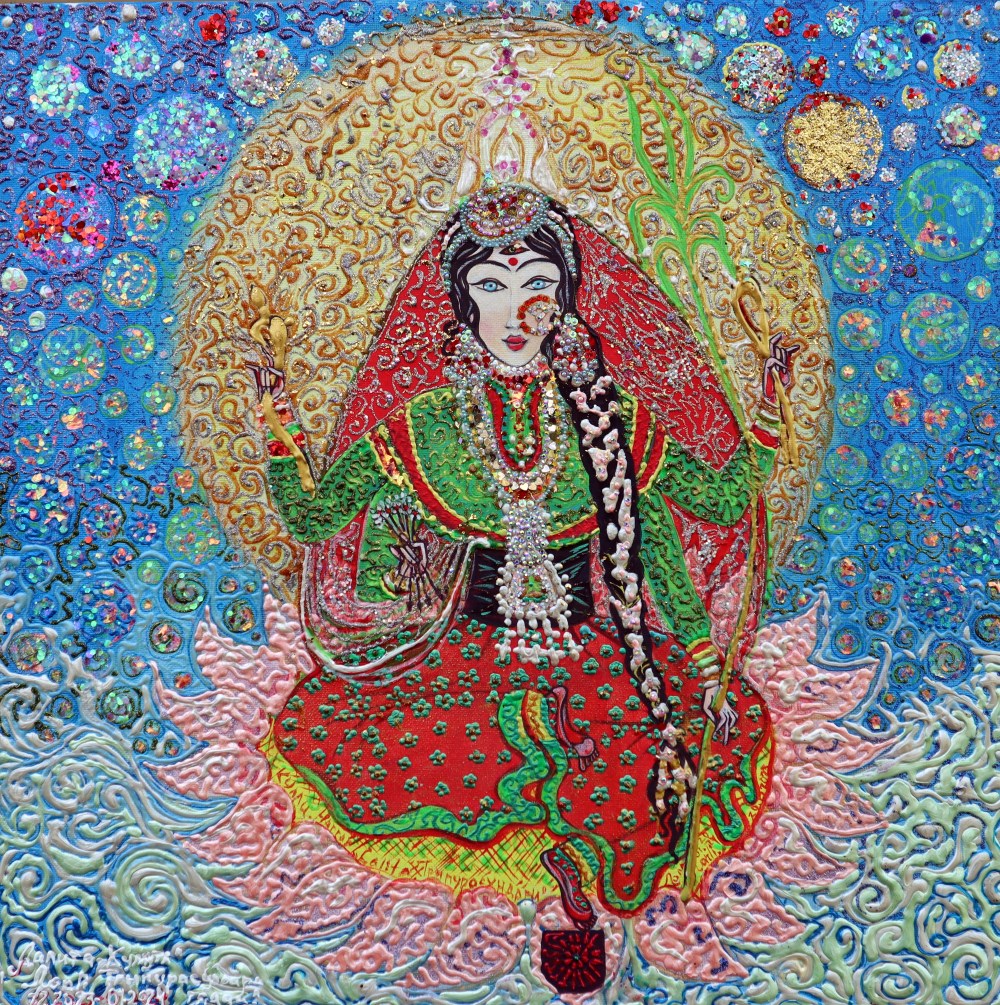
Lalita-Kuluta Tripurasundari-Gaddi
40x40 cm. Mixed media on canvas. 2024
The painting depicts the Mother of the World in her royal position. This is indicated by the names Lalita and Tripurasundari in the title of the painting. This beautiful goddess is deeply revered in the Kullu Valley, where the estate of the great Russian artist N.K. Roerich is located.
Kuluta is the ancient name of the valley used by the Gaddi people living in the valley. Lalita - Kuluta means Lalita from Kullu. In the painting, the goddess is depicted in the festive attire of the Gaddi people, and with the appearance features characteristic of this people. And also with certain special features that are considered the highest beauty among these mountain people. Although the outfit is quite earthly, the goddess is depicted with the canonical position of her arms and legs and with objects that symbolize her essence: a bow made of soft and sweet reeds, 5 arrows made of flowers, a golden goad without a sharp end, a hoop loop made of sweet dough.
How do I understand this? The strength of this Shakti is gentleness and love; she curbs anger and malice with a smile of tenderness and sweet gifts. She kills on the spot with her enchanting gaze, with the promise of sweet hugs, which is why her bow is made of sugar cane and her arrows are made of flowers. She binds you to herself with love, she drives you with the goad of desire to please Her. The positions of the fingers are mudras; they all mean strengthening the meanings embedded in the objects that the Goddess holds, as well as harmonizing the space around. Tender, affectionate, kind, beloved Tripurasundari.
The planets and stars in the painting glow in the dark without backlighting, illuminating its appearance with a gentle greenish light. The moment is depicted when she moved together her eyebrows for a split second, after which the creation of worlds began. And also the state of balanced position of her mind, kept intact in earthly energies and continuing to create. Her left leg rests on the Kalachakra in a black square, this symbolizes the Universe in a sleeping state, which She awakens to creation with Her touch.
Please read the extracts from the classical texts given below to know more about the beautiful Lalita. Her form is described in her Dhyana Stotra as follows.
“I imagine my goddess Bhavani with the color of the rising sun.
Who has eyes like waves of mercy, who has a bow made of sweet reeds, arrows of soft flowers and Aasha, Ankusha in her hands, and who is surrounded by her devotees with great powers, as the personification of the concept of “Self”.
Also details of her appearance can be found in the famous hymn in her honor, Lalita Sahasranama, where she is said to be sitting on a throne like a queen (names 2 and 3), wearing jewels (names 13 and 14), having the favorable marks of a married woman (names 16–25), heavy chest and thin waist (name 36); a crescent moon adorns her forehead and her smile overwhelms Kamesvara, the lord of desires (name 28). She has the legs of Pancha Brahma (five Brahmas) (name 249) as her throne.
She is often iconographically depicted as a 16-year-old girl (hence the name "Shodashi"), sitting on a lotus, which rests on the supine body of Sadashiva, which, in turn, lies on a throne whose legs are the gods Brahma, Vishnu, Ishvara and Rudra. In some cases, the lotus grows from Shiva's navel. In other, more common cases, the lotus is grown directly from the Sri Chakra.
In the Jnana Khanda of Tripura Rahasya, the goddess herself describes her eternal form.
On the island of jewels, surrounded by an ocean of nectar, beyond the universe, there is a mansion built of Chintamani (wish-granting jewel) in a grove of Kadamba (Burbloom) trees. There is a platform with four legs representing Brahma, Vishnu, Mahesha and Ishwara and the platform itself represents the back of Sadashiva. On it is installed my non-transcendental form of Tripura Sundari in the form of eternal consciousness."
"In the Soundarya Lahari it is mentioned that Brahma, Vishnu and Shiva began their cosmic creation when the Supreme Shakti joined her eyebrows for a split second."
"Tripurasundari. This name says that she is the most beautiful in all three worlds. There are many interpretations of the word “tripura”. The Kalika Purana says that in accordance with the desire for creation and manifestation, Shiva’s body became “triple”, the upper part became Brahma, the middle part became Vishnu and the lower part Rudra. Since these three parts (pura) are in Shiva, he is called Tripura, and his consort Tripura. In Kamakala Vilasa, the sage Abhiyukta mentions that the devi created all three forms, she is in everything and in form of three worlds, and exists after the destruction of these worlds, and after their destruction restores them again. In the Brahmanda Purana, it is mentioned that Devi Tripurasundari rules the universe, she is the supreme queen, and Brahma, Vishnu and Shiva are the performers of her actions in her kingdom.
She is present in three nadis - sushumna, pingala and ida (nadis are energy rays in the body, interconnected with the Universe, central sushumna - the sun ray, pingala and ida - the right and left side, the moon ray, the light and dark side of the moon, deity and shakti, as well as yin-yang), she is the ruler of the three shaktis - ichchha, jnana and kriya (intention, knowledge and action). She penetrates all three worlds - heaven, earth and hell. She is the ruler of all three bodies - sthula, sukshma and karana (gross, subtle and causal). She is present in three states - jagrat, swapna and sushupti (waking, dreaming and deep sleep). It penetrates into all three gunas - sattva, rajas and tamas."
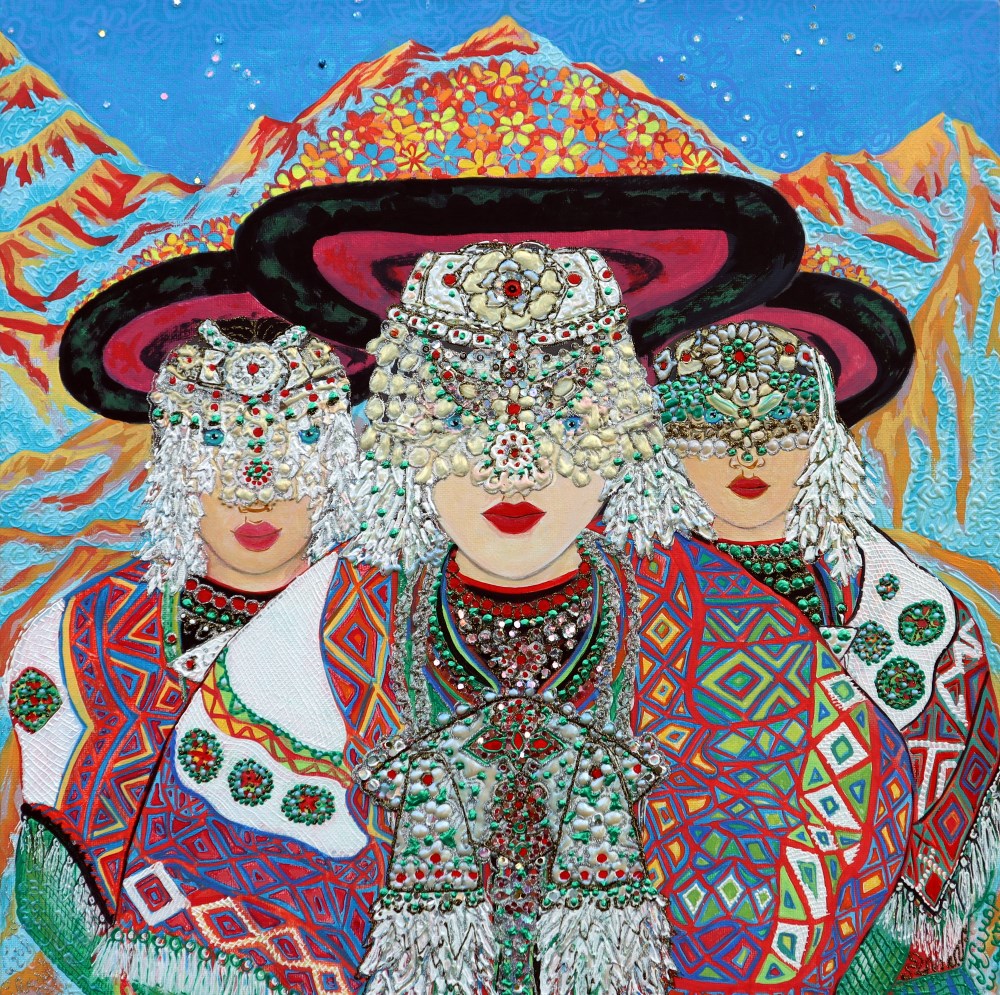
Kinnaur Shakti
40x40 cm. Mixed media on canvas. 2024
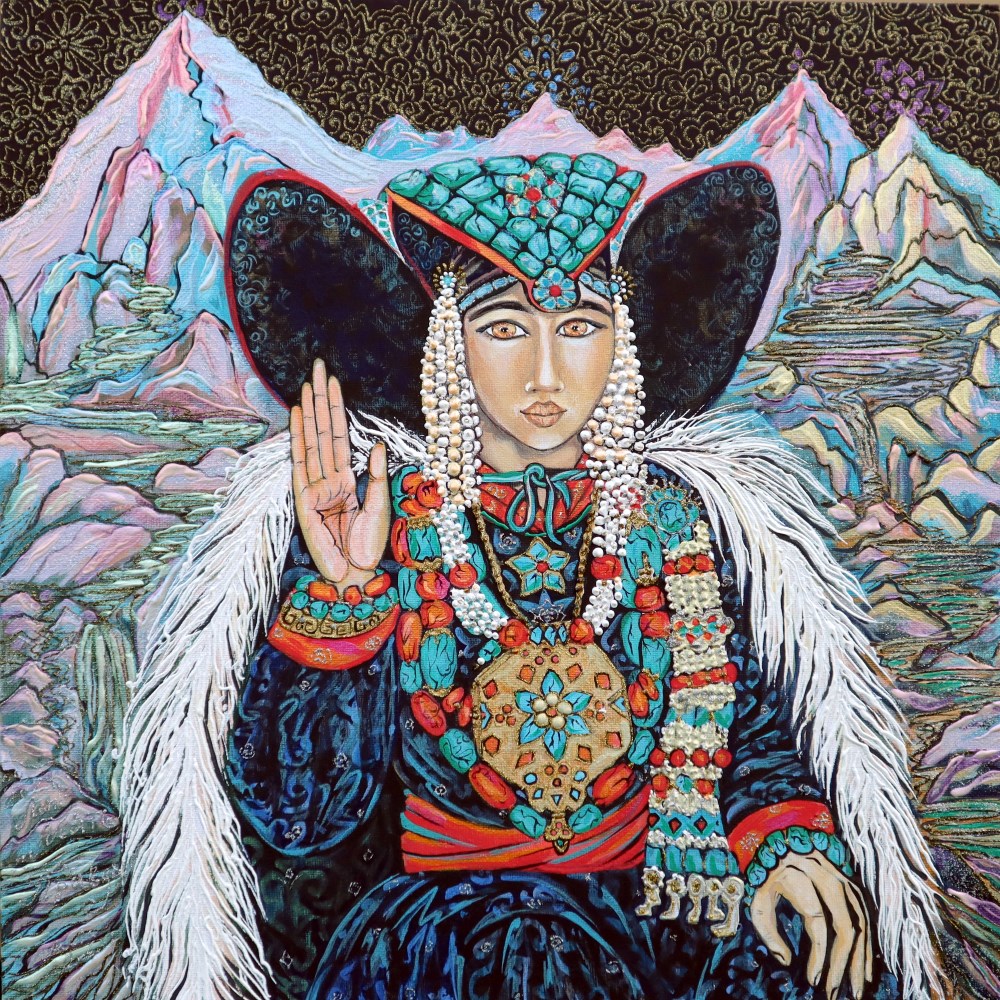
Mother of truth
40x40 cm. Mixed media on canvas. 2024
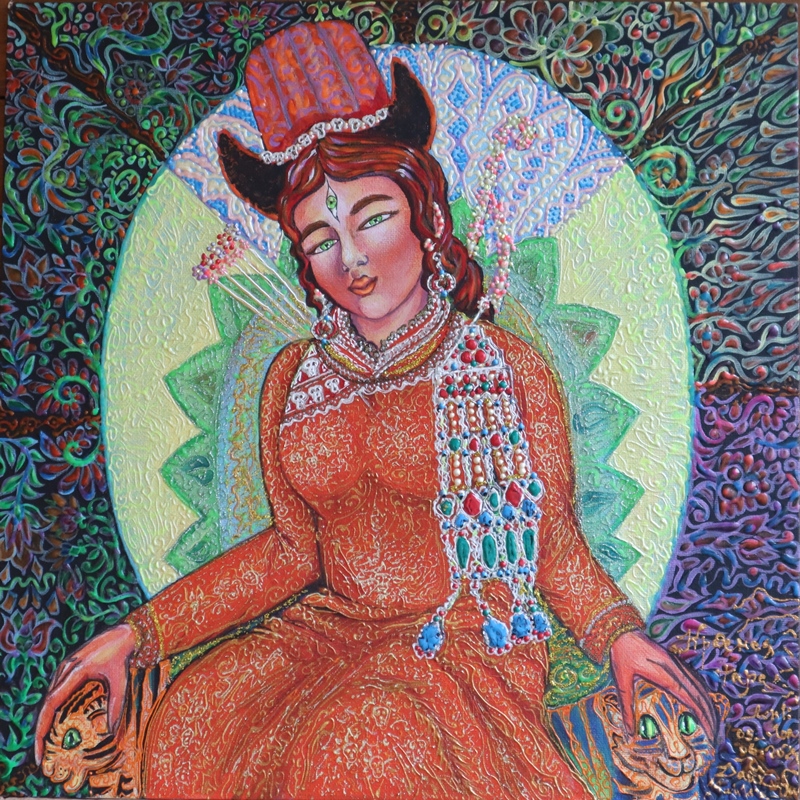
Red Tara. Ladakhi. Dakini Kurukulla
40x40 cm. Mixed media on canvas. 2024
The image of Red Tara is interesting due to its combination of both different cultures and completely opposite meanings. Originating in Hinduism of ancient times as Rati, the wife of the god of love Kama, in Buddhism she appeared as dakini Kurukulla. Her classic image looks quite fierce: red, naked, hung with severed heads, decorated with a crown of skulls, surrounded by fire. But in fact, these are just symbols that do not necessarily mean the first thing that comes to mind when we see them.
So, red color, fire, flame, these are all symbols of life force, energy of love, attraction of the spiritual to the physical, the fall of the spirit into substance . A naked body means strength, health, attractiveness and magic. The severed "human" heads are not actually human, they are the heads of demons of uncontrolled passions. This is a very important symbol, because control over one's demons is essentially the main task of not only Buddhism, but of any other religion. The crown of skulls is nothing more than a symbol of immortality and it is as natural as the sunrise, because life and death always go hand in hand in the manifested world. Her bow and arrows are made of flowers and this means accepting death consciously, as a continuation of life. In my painting, there are five arrows behind the dakini and this is a reference to the fundamental pancasila of Buddhism. Pancasila is the five main rules of spiritual development, if you simplify it, they are well-known to everyone: do not kill, do not steal, do not commit adultery, do not lie, do not cloud the mind. In Tantrism, however, these rules take on the opposite meaning - do not be afraid of sins, be afraid of unconscious submission, attachment to a good mood, as lulling the consciousness.
Why is that? Well, simply because no teaching needs sleepy flies, calmed down in their comfortable little world. What is needed is vibration, the energy of growth, conscious attraction, power, strength, confidence. And no, not submission, not accepting the canons on faith, not blindly following the instructions. The biographies of many teachers of Buddhism are filled with a wide variety of events. Why? Because the energy of overcoming is essentially the energy of the development of the Universe. The energy of submission and rest, in essence is the energy of death. Think about it, only the dead does not fight, does not seek, does not worry, does not make mistakes. The living, life - is always in motion, always striving for more. And love, love is not a calm goodness, love is a force capable of moving mountains, but will never manifest itself completely without obstacles.
In my painting, the dakini Kurukulla, the Red Tara, is depicted in the summer dress of the inhabitants of the highlands of Ladakh, the Ladakhi people. The crown of skulls has become a national headdress, the heads of demons of passions can be found in the patterns of the dress. A beautiful pendant made of silver, pearls, turquoise, red and green jasper is an obligatory decoration for Ladakhi women and symbolizes the four taras of Buddhism. Silver - White Tara - protection and compassion, turquoise - Blue Tara - protection and unity, green jasper - Green Tara - active enlightenment, the mother of bodhichitta, red jasper - Red Tara - love and magic.
Kurukulla is literally translated as the source of wisdom because wisdom is in balance: life is above death, knowledge is above the rest. It is Red Tara who is considered the patroness of secret knowledge, the acquisition of which is impossible without an active search, without significant fascination with the subject of research, which is why She is also the patroness of science. She sits on a shining throne, leaning on the heads of tigers and this is a reference to her ancient Indian origin from the goddess Kali. Cheerful, smiling tigers are often found in the temples and monasteries of the Himalayas, symbolizing the curbing of anger and passion. They are the riding animal of Durga - Kali - Red Tara. Because this is one and the same feminine principle, substance, which accepted the spirit into its womb to create the manifested world. The painting has many layers and several different options for glow. It glows in the sun, shines in fluorescent light and just in the dark. I hope that in Her face I managed to convey all the force of charm and the power of love over us mere mortals.
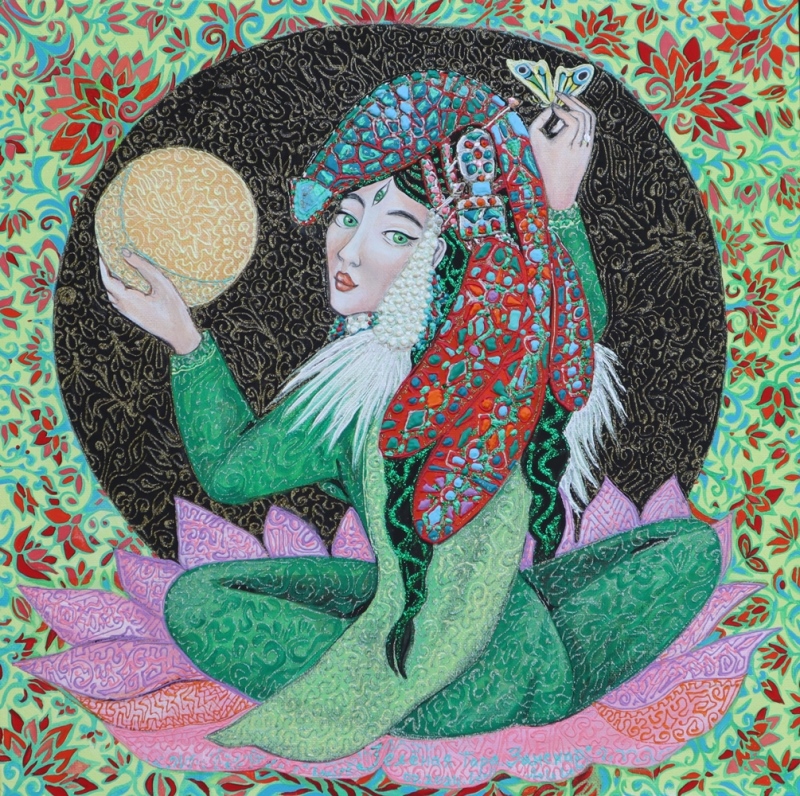
Green Tara. Zanskar
40x40 cm. Mixed media on canvas. 2024

Save the fire of love. Rama Sita. Brokpa
40x40 cm. Mixed media on canvas. 2024
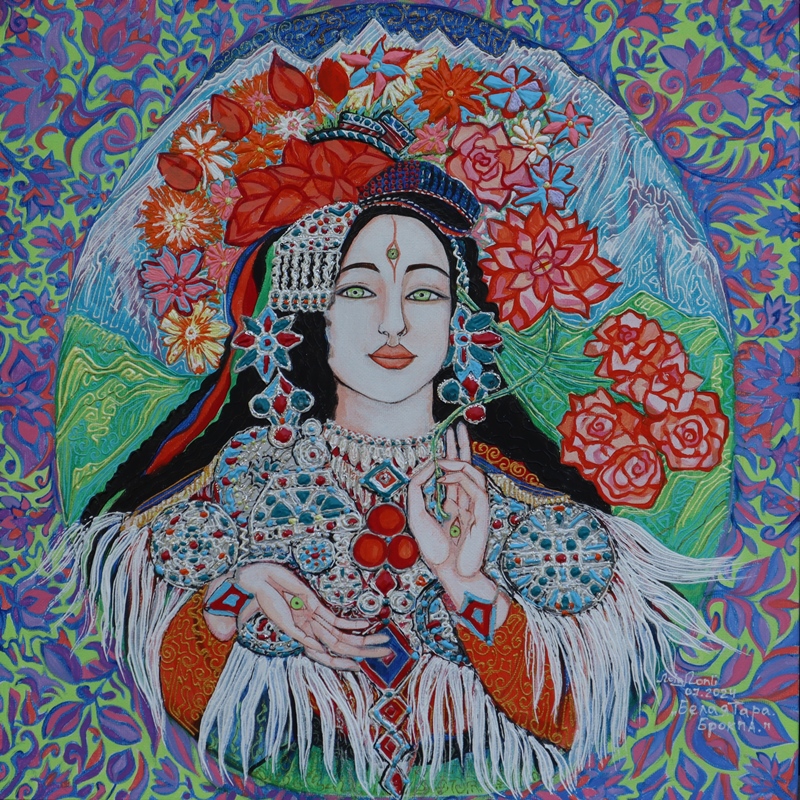
White Tara. Brokpa
40x40 cm. Mixed media on canvas. 2024
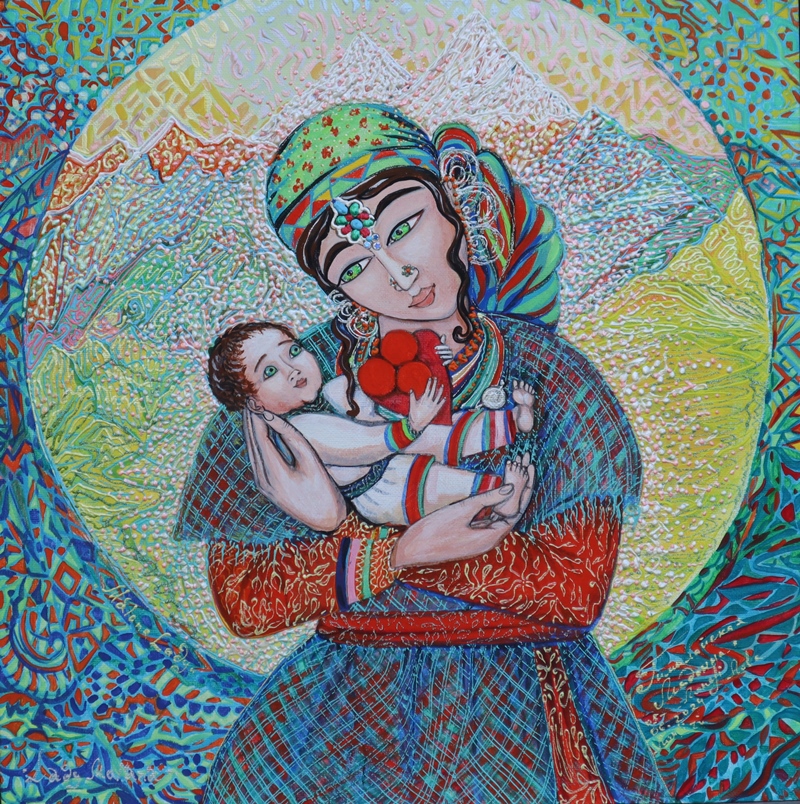
Himalayan Madonna
40x40 cm. Mixed media on canvas. 2024
The residents of the village of Malana in the Indian state of Himachal Pradesh live their own, centuries-old life on the mountain. Their origin is shrouded in mystery, they have unusual beliefs and avoid outsiders. The women of Malana themselves weave fabrics for outerwear. The combination of colors, the number of threads - like a kind of language or even a personal signature, is unique. The main colors, as everywhere in the Himalayas - are green, red, black and white. With this painting, I wanted to elevate motherhood to a divine level. To show that every mother is a reflection of the Blessed Virgin on earth. Regardless of the place of life, traditions and religions, the main job of the mother is to love and take care of her child. So every mother preserves life on Earth. This seemingly simple act is in fact an incredible sacrifice. Giving your own life to another person, for the sake of love and life on Earth. Let us greet mothers with a deep bow of gratitude for the gift of life, let us value life dearly and pricelessly! Always!
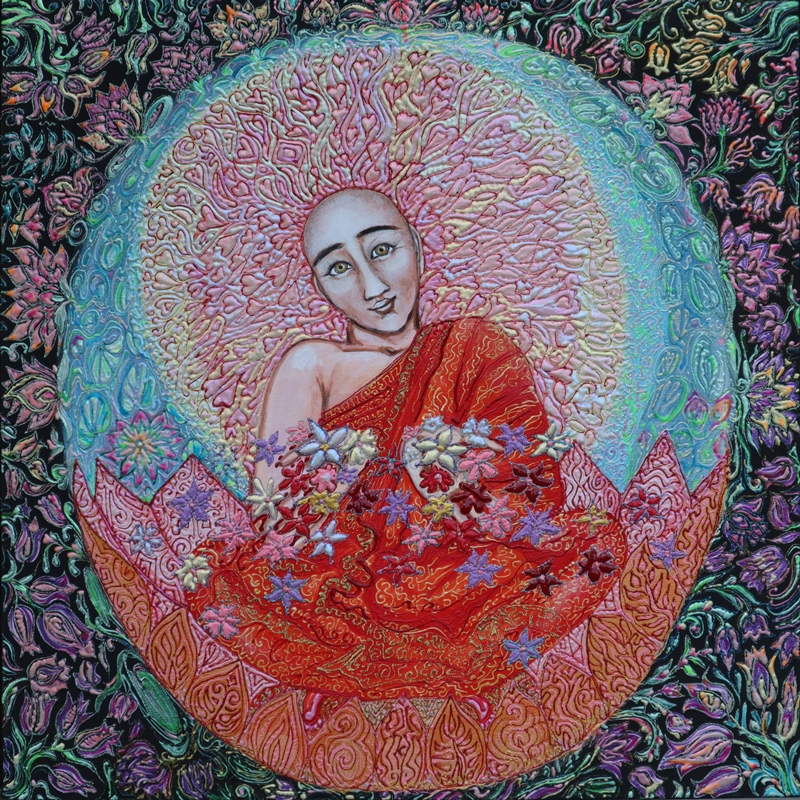
Jovo Atisha - beloved teacher
50x50 cm. Mixed media on canvas. 2024
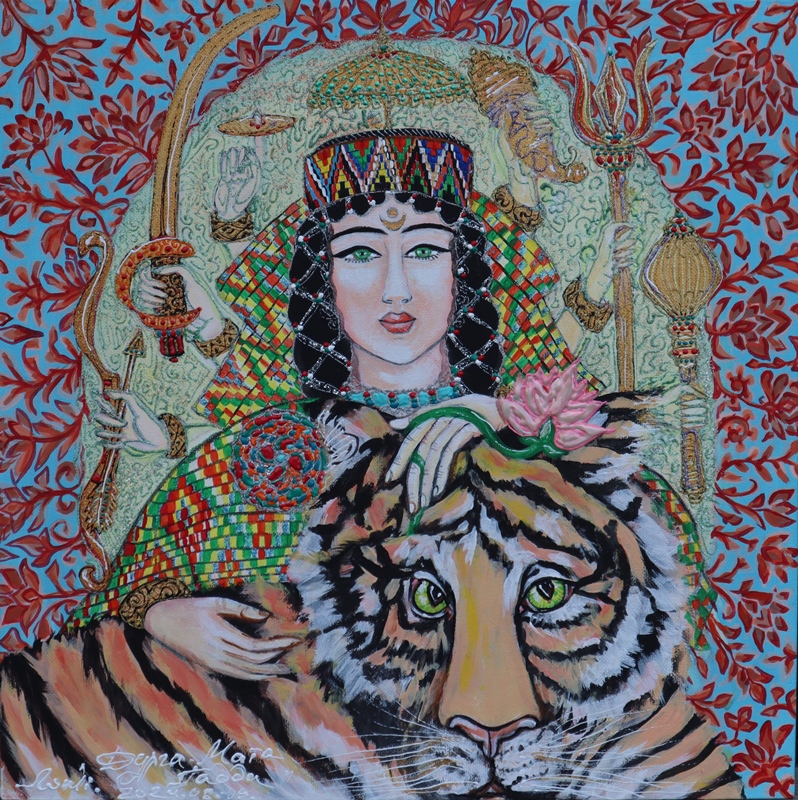
Durga Mata
40x40 cm. Mixed media on canvas. 2024
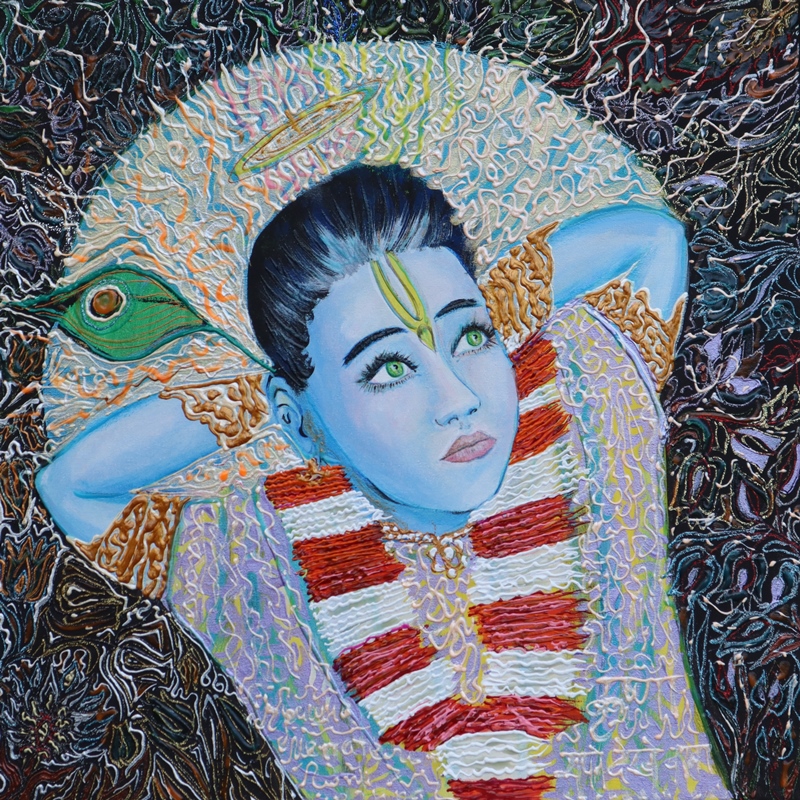
Krishna the dreamer
40x40 cm. Mixed media on canvas. 2024
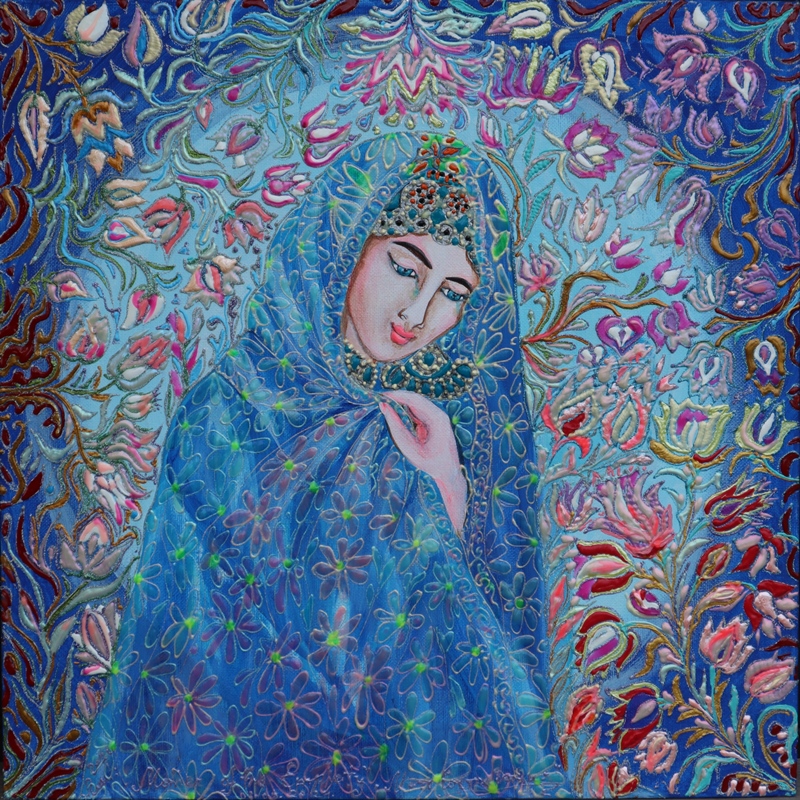
Mother of empathy
40x40 cm. Mixed media on canvas. 2024
Dard of Kargil people's outfit. Mother of compassion loves everything that exists on Earth. She cares about the fate of everyone, from a child to a small insect hurrying home. She saves everyone, She saves Life itself. Her great wisdom is that Life is a miracle, Life is a divine Gift and every living soul has the right to compassion, to help from higher powers. Every most lost person can be reborn to the light. Not to abandon anyone in trouble, this is Her main principle and basic philosophy. This painting was inspired by the image of Fevronia from Rimsky-Korsakov's opera "The Tale of the City of Kitezh...". The wisest words are put into Fevronia's mouth, in essence, her speech is a manifesto of Russian cosmism. Gradually, as the opera progresses, Fevronia tells us how to live so that the world becomes a paradise on earth. And even having ascended to the highest spheres of paradise, She remembers the most lost man, Grishka the Brazhnik (Drunkard), and writes him a heavenly message asking him to repent of his sins and be forgiven, because he is not saved - She is in pain. She is in pain for everyone who does not realize how precious the gift of life is and how much peace, love and beauty we can create in our lives if we are kind. Her tear grows with joy from the awareness of God in everything that exists. Her tear grows for every soul unjustly ruined - after all, this is a scar on God's grace. Her tears heal by the fact that She voluntarily gives up parts of her own heart to establish the magical beauty of the world. The Mother of Compassion is dressed in the attire of the Dard people from the area around Kargil in Ladakh, because I deeply admire the ability of different peoples with different religions to peacefully coexist on a patch of mountain land, even despite the artificially created military conflicts of the past years. May goodness and love and compassion come to our entire Earth! And may the Kingdom of God come on Earth!
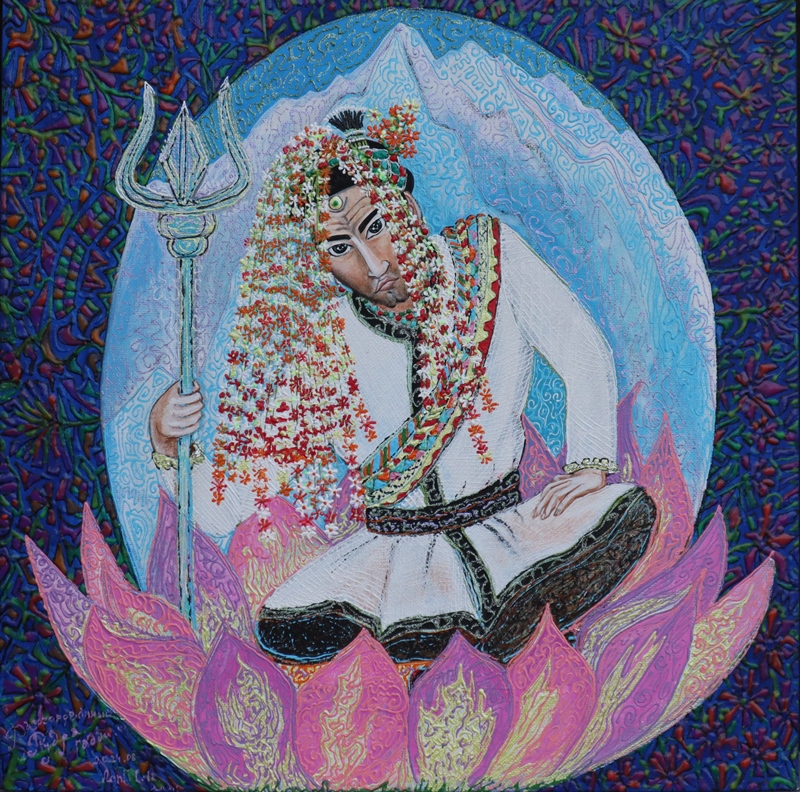
Disappointed Rudra. Kullu festive attire
40x40 cm. Mixed media on canvas. 2024
In my painting, the fiercest avatar of Shiva is depicted in the festive attire of the Himalayan people of Kullu. What is the connection between the fierce Rudra and the Himalayan people, whose men abundantly decorate themselves with flowers? For those who study Hinduism and are familiar with the history of incarnations and various aspects of the divine power called Shiva, it looks unconventional. No big deal, we will explain, because there is already quite a lot of understandable art in the world... So, who is Rudra in my painting and why is he disappointed? Rudra Shiva is a loudly roaring, fierce bull, the father of thunder and lightning. The only god, whose rage and anger frees from the current incarnation and the entire wheel of samsara, completely burning the karma of a living being. Traditionally, Rudra is equipped with a black bow and arrows, instantly relieving the pain and suffering of earthly existence. The bow and arrows in my painting symbolize the eyes and eyebrows. The glance from under the brows pierces the viewer, asking and affirming - well, why did you make mistake again, my friend? After all, my patience is not limitless. If you do not grow and change, evolve, as you should, I will make you do it through pain. This is all Rudra. His essence is beautiful and tender, like spring flowers - He wants liberation for all that exists. He cares how we go and what we are. He is offended by our miring in the swamp of self-admiration and self-exaltation. He is disgusted by pretense and hypocrisy. He hates those who smile in your face, who hold a stone in their bosom, envious people. He is disappointed and upset by consumers, squanderers of other people's time and energy. Those who take energy and inspiration from others, and do not want to give anything back, being in self-satisfaction - I have little as it is. Rudra is disappointed with greedy, lying traitors, pretending to love, but in every breath putting only themselves and their achievements above all. Rudra hates show-offs. Rudra is not obliged to prove anything to anyone. Rudra can move mountains and strike the clear sky with thunder, but he waits for centuries and tolerates our imperfection. The second aspect of the powerful Rudra is healing and protective. It is to him that people in India turn with requests for healing and protection on the road and in war. Isn't it strange? After all, there are other kind and "balanced" gods who do not periodically fall into anger? Why do they ask Rudra and not others? It's simple. Because He really can. He can do any miracle, he has enough wisdom and strength. But... If the petitioner is a rogue, a thief, a vampire or a whiner, he will not be given any indulgence - he will hit him with his trident so hard that it will not seem like a little! His trident symbolizing the world of ancestors, the physical world and the mental world, - is a reflection of the essence of each person. After all, each person consists of a culture extracted from the previous experience of mankind, from the physical body and from the mind, analyzing everything that happens. That is, the blow of His trident is essentially a straightening of the brains of someone who has followed the lead of temporary madness, exalting himself to the rank of God. Rudra's grounding blow is a redirection of thinking from - what is useful and necessary for me, to - I am the result of the labors of many generations, I must be worthy and continue to grow. In my painting, Rudra is decorated with flowers of the spring festival in the Himalayas, because He is truly kind, cheerful and healing for truly pure and good people. His piercing gaze is addressed to those who have forgotten themselves, enchanted by the physical world and think that God does not know their disgusting deeds and dirty thoughts. They are known. And His patience is not limitless. But His punishment is the highest justice, because He does only what is necessary for His children's evolutionary development.
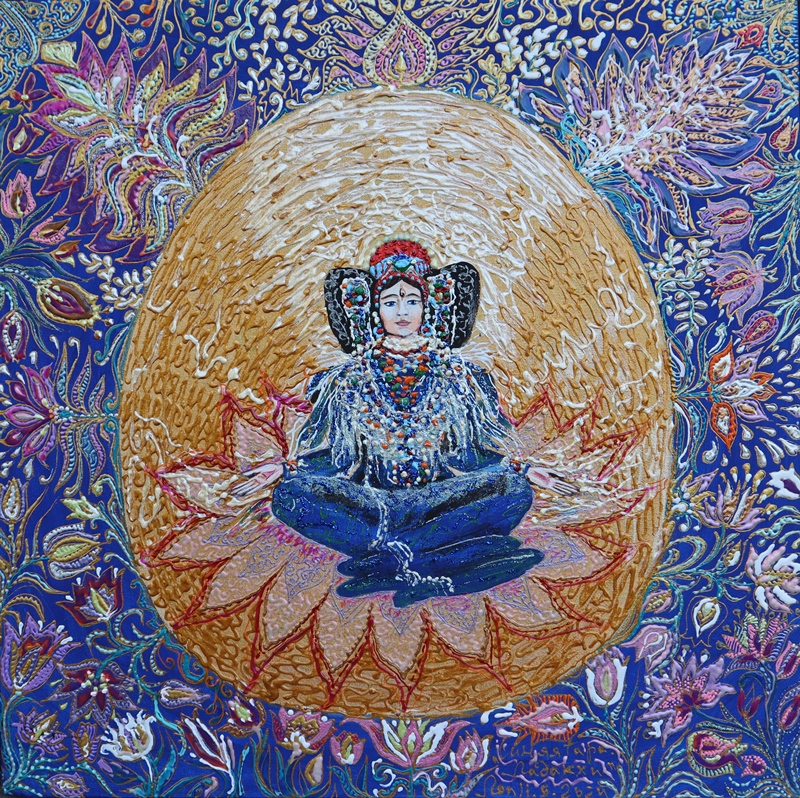
Blue Tara. Ladakhi
40x40 cm. Mixed media on canvas. 2024
Blue Tara in Buddhism is the main defender of the faith and its devotees. She continuously consciously sees the world, sees where the darkness is hiding. From her keen sense of knowledge, darkness cannot hide behind other people's appearances or high-flown words. Blue Tara will see evil and will certainly defeat it. Her energy is such that it harmonizes the space around her. Everything beautiful and blissful, harmonious - comes to life near Her. Her dress resembles the tail of a coiled snake to emphasize the connection between the images of taras in Buddhism and nagas in Hinduism. The clothes of the Ladakhi people on Blue Tara indicate that Ladakh is now the main keeper of Buddhist wisdom. In the mountain monasteries of Ladakh, great lamas, unknown to us, help our world not to fall apart. Always nearby is the keeper of Buddhism - Blue Tara..

Soul of the third eye
40x40 cm. Mixed media on canvas. 2024
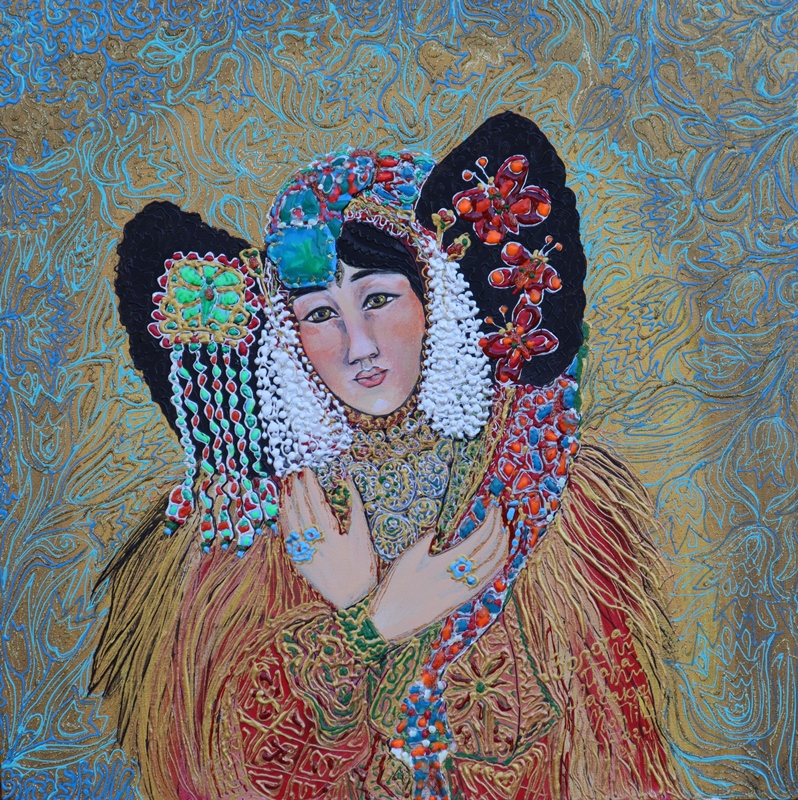
Golden Tara. Ladakhi
40x40 cm. Mixed media on canvas. 2024
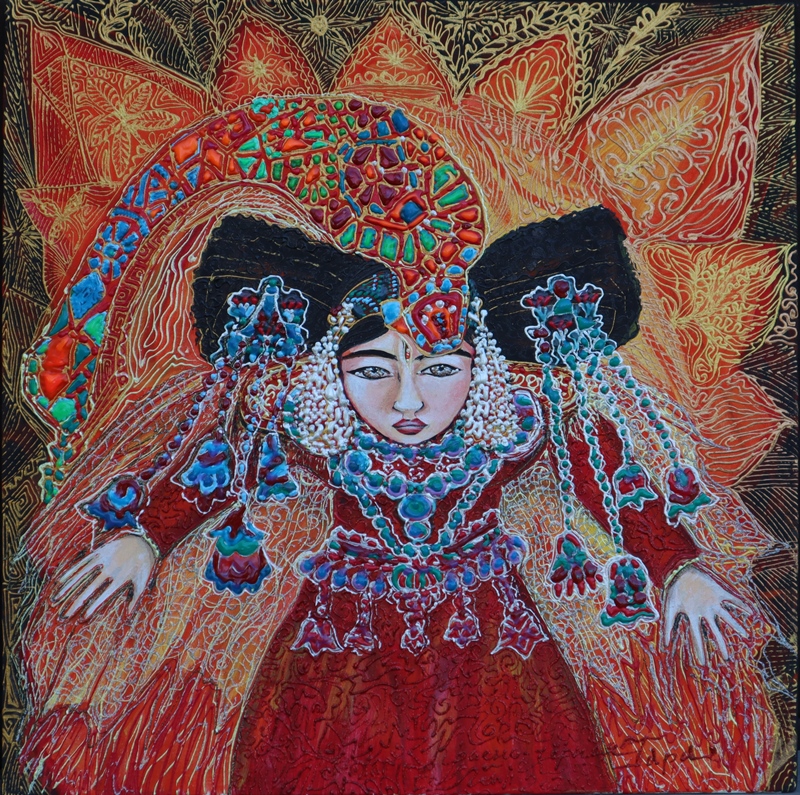
Red-black Tara. Ladakhi
40x40 cm. Mixed media on canvas. 2024

Orange Tara. Brokpa
40x40 cm. Mixed media on canvas. 2024

